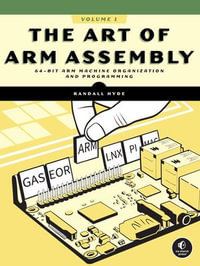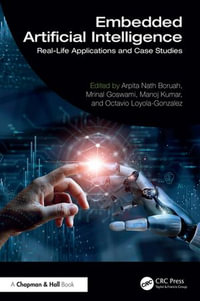
eTEXT
Mastering Embedded Linux Programming
Harness the power of Linux to create versatile and robust embedded solutions
By: Chris Simmonds
eText | 29 December 2015 | Edition Number 1
At a Glance
eText
$67.09
or
OR
Free with Kobo Plus Read
Start Free Trial *- Subscribe and read all you want.
- $13.99 a month after free trial. Cancel Anytime. Learn more.
Instant online reading in your Booktopia eTextbook Library *
Read online on
Desktop
Tablet
Mobile
Not downloadable to your eReader or an app
Why choose an eTextbook?
Instant Access *
Purchase and read your book immediately
Read Aloud
Listen and follow along as Bookshelf reads to you
Study Tools
Built-in study tools like highlights and more
* eTextbooks are not downloadable to your eReader or an app and can be accessed via web browsers only. You must be connected to the internet and have no technical issues with your device or browser that could prevent the eTextbook from operating.
Harness the power of Linux to create versatile and robust embedded solutions
About This Book
• Create efficient and secure embedded devices using Linux • Minimize project costs by using open source tools and programs • Explore each component technology in depth, using sample implementations as a guide
Who This Book Is For
This book is ideal for Linux developers and system programmers who are already familiar with embedded systems and who want to know how to create best-in-class devices. A basic understanding of C programming and experience with systems programming is needed.
What You Will Learn
• Understand the role of the Linux kernel and select an appropriate role for your application • Use Buildroot and Yocto to create embedded Linux systems quickly and efficiently • Create customized bootloaders using U-Boot • Employ perf and ftrace to identify performance bottlenecks • Understand device trees and make changes to accommodate new hardware on your device • Write applications that interact with Linux device drivers • Design and write multi-threaded applications using POSIX threads • Measure real-time latencies and tune the Linux kernel to minimize them
In Detail
Mastering Embedded Linux Programming takes you through the product cycle and gives you an in-depth description of the components and options that are available at each stage. You will begin by learning about toolchains, bootloaders, the Linux kernel, and how to configure a root filesystem to create a basic working device. You will then learn how to use the two most commonly used build systems, Buildroot and Yocto, to speed up and simplify the development process. Building on this solid base, the next section considers how to make best use of raw NAND/NOR flash memory and managed flash eMMC chips, including mechanisms for increasing the lifetime of the devices and to perform reliable in-field updates. Next, you need to consider what techniques are best suited to writing applications for your device. We will then see how functions are split between processes and the usage of POSIX threads, which have a big impact on the responsiveness and performance of the final device The closing sections look at the techniques available to developers for profiling and tracing applications and kernel code using perf and ftrace.
Style and approach
This book is an easy-to-follow and pragmatic guide consisting of an in-depth analysis of the implementation of embedded devices. Each topic has a logical approach to it; this coupled with hints and best practices helps you understand embedded Linux better.
About This Book
• Create efficient and secure embedded devices using Linux • Minimize project costs by using open source tools and programs • Explore each component technology in depth, using sample implementations as a guide
Who This Book Is For
This book is ideal for Linux developers and system programmers who are already familiar with embedded systems and who want to know how to create best-in-class devices. A basic understanding of C programming and experience with systems programming is needed.
What You Will Learn
• Understand the role of the Linux kernel and select an appropriate role for your application • Use Buildroot and Yocto to create embedded Linux systems quickly and efficiently • Create customized bootloaders using U-Boot • Employ perf and ftrace to identify performance bottlenecks • Understand device trees and make changes to accommodate new hardware on your device • Write applications that interact with Linux device drivers • Design and write multi-threaded applications using POSIX threads • Measure real-time latencies and tune the Linux kernel to minimize them
In Detail
Mastering Embedded Linux Programming takes you through the product cycle and gives you an in-depth description of the components and options that are available at each stage. You will begin by learning about toolchains, bootloaders, the Linux kernel, and how to configure a root filesystem to create a basic working device. You will then learn how to use the two most commonly used build systems, Buildroot and Yocto, to speed up and simplify the development process. Building on this solid base, the next section considers how to make best use of raw NAND/NOR flash memory and managed flash eMMC chips, including mechanisms for increasing the lifetime of the devices and to perform reliable in-field updates. Next, you need to consider what techniques are best suited to writing applications for your device. We will then see how functions are split between processes and the usage of POSIX threads, which have a big impact on the responsiveness and performance of the final device The closing sections look at the techniques available to developers for profiling and tracing applications and kernel code using perf and ftrace.
Style and approach
This book is an easy-to-follow and pragmatic guide consisting of an in-depth analysis of the implementation of embedded devices. Each topic has a logical approach to it; this coupled with hints and best practices helps you understand embedded Linux better.
Read online on
Desktop
Tablet
Mobile
ISBN: 9781784399023
ISBN-10: 1784399027
Published: 29th December 2015
Format: ePUB
Language: English
Publisher: Packt Publishing
Edition Number: 1





















